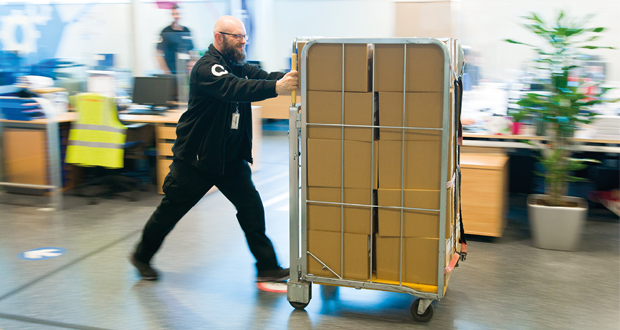 Neil Phillips of Restore Digital discusses current mailroom trends, how the pandemic propelled change and what challenges they are currently facing
Neil Phillips of Restore Digital discusses current mailroom trends, how the pandemic propelled change and what challenges they are currently facing
The mailroom is a central nervous system to business operations. But the mailroom we once knew has changed. As technology evolved and organisations began to demand greater efficiencies, the modern-day digital mailroom was born. The days of the traditional mailroom with a post-receiving department and trolley delivery service will soon be a thing of the past. The service has morphed into mail being scanned upon receipt and digital copies dispatched to recipients. This approach allows for more efficient and streamlined management of communications.
THE IMPACT OF THE PANDEMIC
The onset of the pandemic expedited the change that was already in motion, as with it came the prerogative to avoid the handling of post – not to mention the logistics of getting post to the right people, given everyone was sent home, which spiked a demand for a digitised mailroom service. For healthcare and legal practices, the processing of post was still very much vital and did not slow down. During 2020, we saw cases where some services started out as being a traditional onsite mailroom with 95 per cent paper services convert to 95 per cent digital services within nine months as people began to work from home and digital PDF scans were demanded.
The technology we have seen implemented over the last three years isn’t new. It has been available for quite some time but was rarely implemented, largely due to initial set-up costs. The pandemic forced many industries to take a closer look at digitalising and even outsourcing their mailroom services, so they were off site to repurpose floorspace.
As a result of lockdown, many organisations had to re-evaluate their budget and investment calculations. With many employees working remotely, the need for efficient mailroom services has become even more critical, and therefore the upfront cost has become less of a concern. While the initial upfront costs could be high for larger facilities, the ROI brings significant benefits.
Mailroom workers that were used to opening or scanning post were upskilled and now their roles incorporate tech and require digital knowledge.
COLLABORATION WITH CUSTOMERS
Different perhaps to common misconceptions that technology drives people apart, tech in the mailroom has brought the mailroom and organisation closer together. Digital integration has led to creating closer working relationships between mailroom providers and customers. The process of setting up and using technology requires an intently collaborative approach; the right set up process is critical.
The success of any digital mailroom service is generated three stages before implementation. To future-proof operations, both the mailroom provider and the customer have to have a full appreciation of what and how the end user will access information, how the customer will use it, and how the service could deliver further benefits.
AROUND THE WORLD, AROUND THE CLOCK
The modern-day digital mailroom operates to strict service level agreements. Post can be available to staff in their own workstreams at the start of the working day, which is often critical for legal practices, banks, insurance companies and importantly healthcare practices. A recent survey conducted by Restore Digital reveals that 30 per cent of respondents who rely on traditional mailrooms cite delays in processing inbound mail as having a negative effect on their performance or reputation.
For some clients, certain departments are based overseas. For example, HR teams can be based off-shore and that involves a huge amount of data control and security. Typically, the off-shore HR team would receive physical contract declarations and rights to work that they would then load onto their system. Now, this sensitive data can be simply scanned on site in the UK and the mailroom can index and upload into the central repository making it efficient and secure for the HR team to access. This can be saved straight to an employee’s HR file, omitting any need to manually file documents. A number of Restore Digital customers employ a system which uses AI to recognise the information in the PDF without the need for manual input and can send alerts to a designated person to review and validate the information. This means a significant reduction in physical mail and sensitive documents being sent around the country or, indeed, around the world, engineering a far more secure and data sensitive digital data flow.





